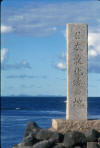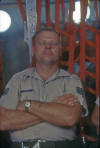J and D's Corner
Our Photo Attic - Stuff from Here & There
Wakkanai Air Station, 1966 -1967
Located at the northern end of Japan's most northerly island, Hokkaido, Wakkanai AS (click for audio file) was blessed with a climate that, coupled with it's distance from any major population centers, made it pretty much the end of the earth in the minds of most Japanese, and to the GI's stationed there. There was at that time only a small airport with, as far as I recall, no civilian air service. Our normal access to and from the "outside" was via sling-seated USAF cargo C130s and slightly more plush but elderly DC-4s operated by the CIA's Air America. Air America was preferred, not only because of the better seating but because the Air America pilots seemed to be able to get in & out in spite of weather that caused the USAF pilots to give up (paid by the landing? Who knows?). For aviation types, the only navaid was a Tacan unit maintained by the USAF, I have no idea what the minimums were but whatever they were, it was frequently worse. Japanese came and went via train, as did GIs when the weather simply closed down for too long.
Being only miles from the big Russian island of Sakhalin and not much farther from the eastern Russia/China border region the antenna arrays & receivers at Wakkanai could monitor all kinds of military & civilian communications for analysis. For example, some may recall the cold-war incident where Russian interceptors without warning shot down a Korean Air Lines 747, killing 286 including U.S. Congressman Lawrence McDonald. In the aftermath, Russia disclaimed any knowledge of the event, leading to the US release of recorded conversations between the Russian pilots and their ground controllers, including the order to shoot. This was recorded at Wakkanai.
Today such ELINT activity has pretty well been taken over by the NSA's massive satellites, which collectively can cover the globe, and Wakkanai AS is no more. While it was in operation, though, it was quite a place to live and seemed to be so to virtually everyone who served there. As an enclave of only a few hundred Americans adjacent to what was then just a remote fishing town, it was a tight community where people worked and partied hard.
Much of the isolation was related to the long winters, when cold winds from Russia persistently swept across the warmer Sea of Japan, picking up moisture and creating seemingly endless snowfall. Sometimes heavy, sometimes light, this "lake effect" snow was seldom absent from Halloween until mid-March, with totals running up to - and beyond - 300 inches not that unusual. Roadways on the station were kept clear using huge snow-blower and roll-over blade equipped trucks, but off post it was simply allowed to accumulate, resulting in several feet of rock-hard ice on the roadways by springtime that was broken up by heavy equipment and dumped into the adjacent sea.
No one had cars, so travel was pretty much limited to the immediate area and in any case off-post entertainment was essentially represented by a few nearby bars catering to both Americans & Japanese. The bars featured a rotating staff of bar girls provided by the Yakuza (a "business" not nearly as grim or evil as it sounds, that's another whole world to write about).
The "downtown" Japanese population was friendly but not cosmopolitan and few spoke much English, so few GIs made the effort to traverse the road into the main town area. The result was that entertainment for much of the year was limited to the local bars, the military clubs, long-running parties hosted by the lucky families who had one of the limited number of on-station housing units, and my assigned 'home', the tiny AFRTS (American Forces Radio & Television Service) radio & TV station.
For families like ours who were shut out of the "on-post housing" lotto, the alternative was to rent one of a limited supply of tiny off-post apartments. For us to be allowed to rent, these had to be specially equipped to USAF minimum standards, primarily the requirement that there be a flush toilet. Most Japanese homes in our outlying area of Wakkanai had only an "in-house outhouse", a pit toilet, usually in a corner of the house or sometimes recessed into a projecting enclosure, that could periodically be pumped out by a small "honey bucket" truck from outside the building. This wasn't as smelly as it sounds, at least in winter, as they didn't heat the benjo area, a situation not conducive to long reading sessions. Whatever, our little apartment, tiny as it was and with only a single tatami-floored bedroom, served nicely for the five of us (see pictures below).
As mentioned above, those families who occupied the limited number of on-post housing units regularly hosted parties that would continue at varying levels of intensity for sometimes 24 hours or more, as shift workers (and the host/hostess!) came & went. Areas behind couches were generally reserved for individuals or couples taking a break from the festivities, a good use of resources in my view. Since our off-post apartment initially had no clothes-washing provisions, D. would frequently load up the kids & laundry on a sled and trek out to a friend's place where wash could be done (picture below). Later on we bought a tiny Japanese wringer washer that could do a couple of pieces of clothing at a time, cutest thing you ever saw. D. wanted to bring it back to the States but I balked.
The presence of my little job, the radio-TV station, was another entertainment factor enjoyed by all. We had a 100-watt AM radio transmitter out at the airport where it wouldn't interfere with the ELINT activities, a situation further insured by airport height restrictions which dictated a crappy antenna. In fact, the signal was barely usable in parts of the Air Station. For the same reason the TV signal was fed to viewers only via on-post cable (well, mostly on-post, the subject of a sidebar story). In those days AFRTS world-wide operations were just about at a post-WWII peak, with manned stations all over the world and with TV facilities starting to be installed on ships at sea. Radio programming was mostly fed from our network's main station in Tokyo, although we did a few hours of local DJ and local news stuff every day. TV, which was strictly black-and-white, came off 16mm film and "kinescope" (film shot from a TV monitor, essentially), again rounded out with a little local programming, primarily an evening news show. We only had enough fresh TV material to run from around 3 or 4 PM until midnight, with some extra added on Saturday & Sunday. The station had a small staff and we all worked long & flexible hours, but it was a fun time. Wives & kids frequently dropped by to visit, making it one big happy family.
For a whole lot more on Wakkanai Air Station and the town of Wakkanai, past & present, check out THIS WEBSITE, which is a good illustration of how people related to Wakkanai. Much, much larger and more active postings don't generate anything approaching this kind of alumni interest. The website, as an aside, is the work of David Lynch, son of my Wakkanai co-worker Al Lynch (now unfortunately deceased) who appears in a couple of the pictures below.
The pictures below have minimal mouse-over pop-up labels, click on the thumbnail picture for the full-size version. I may get around to setting them up with better explanations...or maybe not.
Wakkanai Air Station - 1966/1967



 /
/



AFRTS Far East Network (FEN) Radio/TV Station & Staff
Living in Wakkanai - Our apartment off-post & scenes
Sidebar Story- The Great Wakkanai Bootleg TV Caper: As noted, the AFRTS TV was distributed only "on-post" through a cable system; those of us living off post had only Japanese-language broadcast which wasn't too interesting or informative to us. Since I was 'chief engineer' and my neighbor across the alley, Jim Burwell, was our 'program director', we felt this wasn't an acceptable state of affairs.
After some totally non-productive efforts to get something done officially we gave up & decided to forge ahead. Taking up a collection from our neighboring off-post GI's to help defray the cost we mail-ordered a couple of rolls of RG-59 coax, a cheap distribution amplifier & some connectors with the intent of "bootlegging" a feed. Immediately across the main road from our alley entrance was the post's boundary & supply warehouse building with a cable feed, so the first step was to sweet-talk the chief who ran the warehouse into letting us string cable off his building without "noticing" anything. Jim & I then went to the Wakkanai city officials and secured a permit to run an aerial cable across the main road. We sort of neglected to mention to those nice folks that this was an unsanctioned activity. The mama-san of a 2-story bar just across the road at the head of our alley allowed us to attach to the upper part of her building, then it was a simple run down the alley to an amplifier in my apartment and thence to the waiting families in our little ghetto. So finally American TV came to the denizens Emi Dori alley.
All this was always somewhat fraught with the potential for bad outcome, as for one thing the ELINT folks and their CIA clients were really, really paranoid about security, and someone could have come to the conclusion this was some nefarious Russian scheme for siphoning away classified data. Secondly, we had already been turned away in our quest to create some official solution (which in any case would have taken years and it was a max 18-month tour!). But we figured the old saw about it being easier to beg forgiveness than get permission should control.
What actually happened is that the system served nicely until sometime after I had gone onward to my next assignment. Probably due to the proverbial 'loose lips' it apparently became more widely known around the post that the system existed, and due to a confluence of events there was indeed a blow-up. As I got the story, a new facility (a hospital/clinic building) was completed and needed a TV feed, but when they went to look for a roll of "hard-line" cable that supposedly was sitting in a storage area it couldn't be found. This was a contractor thing so I don't know what the real situation was, but someone in authority decided we had stolen and used the hard-line cable in our bootleg efforts. A 60-second look at things would have shown this wasn't the case, but there was some pressure to bring us miscreants to justice anyway. Fortunately I had enough goodwill stored up to deflect it all, but the great Wakkanai TV bootleg became history.




































